2013 KCSE Physics Past Paper
3.5.1 Physics Paper 1 (232/1)
SECTION A (25 marks)
Answer all the questions in this section in the spaces provided.
1 Figure 1 shows part of the main scale and vernier scale of a vernier callipers.
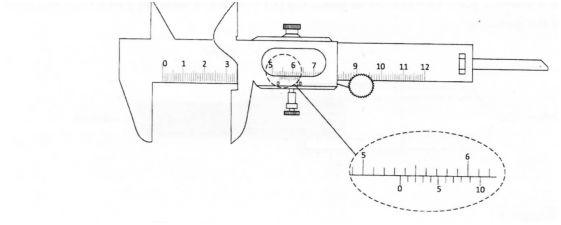
Figure 1
Record the reading indicated. (1 mark)
2 State one factor that affects the turning effect of a force on a body. (1 mark)
3 Figure 2 shows some air trapped by mercury in a glass tube. The tube is inverted in a dish containing mercury.
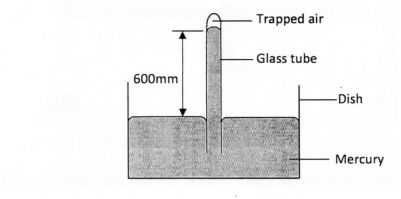
Figure 2
Given that the atmospheric pressure is 760 mmHg and the height of mercury column in the tube is 600 mm, determine the pressure of the air trapped in the tube in mmHg. (3 marks)
4 An object of weight 20 N attached at the end of a spring causes an extension of 0.5 cm on the spring.
(a) Determine the spring constant of the spring. (2 marks)
(b) Determine the weight of an object that would cause an extension of 0.86 cm when attached at the end of the same spring. (1 mark)
5 State two measurements you would take in an experiment to determine the upthrust of an object which is immersed in a fluid. (2 marks)
6 State how the measurements in question (5) are used to determine the upthrust of the object. (1 mark)
7 Figure 3 shows a piece of wood fitted into a copper pipe and a piece of paper wrapped tightly around the junction.
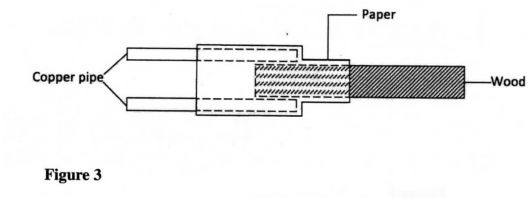
Figure 3
It is observed that when a flame is applied around the paper at the junction, the side of the paper around the wood burns first. Explain this observation. (2 marks)
8 Figure 4 shows a uniform metre rule of weight I N with two weights of 0.18 N and 0.12 N suspended from its ends.

Figure 4
Determine how far from the 0.18 N weight a pivot should be placed in order to balance the meter rule. (3 marks)
9 Explain why brakes fail in a hydraulic braking system when air gets into the system.
10 Figure 5 shows a Bunsen burner.
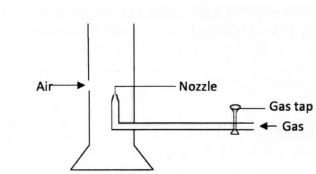
Figure 5
Explain how air is drawn into the burner when the gas tap is open. (3 marks)
11 Figure 6 (a) and 6(b) show capillary tubes inserted in water and mercury respectively.
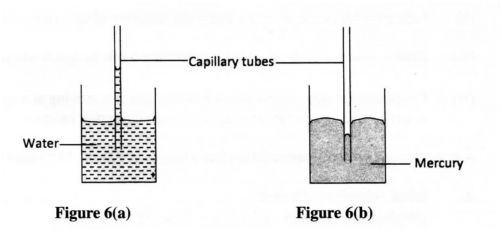
It is observed that in water the meniscus in the capillary tube is higher than the meniscus in the beaker, while in mercury the meniscus in the capillary tube is lower than the meniscus in the beaker. Explain these observations. (2 marks)
12 State why it is necessary to leave an air space in a closed glass bottle of water when it is to be kept in a refrigerator. (1 mark)
13 A drop of blue ink is introduced at the bottom of a beaker containing water. It is observed that after some time, all the water in the beaker turns blue. Name the process that takes place. (1 mark)
SECTION B (55 marks)
Answer all the questions in this section in the spaces provided.
14 (a) State two ways in which the centripetal force on a body of mass m can be increased (2 marks)
(b) Figure 7 shows an object at the end of a light spring balance connected to a peg using a string. The object is moving in a circular path on a smooth horizontal table with a constant speed.

Figure 7
(i) State what provides the centripetal force. (1 mark)
(ii) Indicate with an arrow on the figure the direction of the centripetal force. (1 mark)
(iii) State a reason why the object is accelerating while its speed remains constant. (1 mark)
(iv) Given that the mass of the object is 0.5 kg and it is moving at a speed of 8 ms-1 at a radius of 2 m, determine the reading on the spring balance. (3 marks)
(c) A stone thrown vertically upwards reaches a height of 100 m. Determine the: (i) initial velocity of the stone. (2 marks)
(Neglect air resistance and take g = 10 ms-2)
(ii) total time the stone is in air. (2 marks)
15 (a) State the meaning of the term “specific latent heat of fusion”. (1 mark)
(b) Figure 8 shows a set up of apparatus used in an experiment to determine the specific latent heat of fusion of ice.
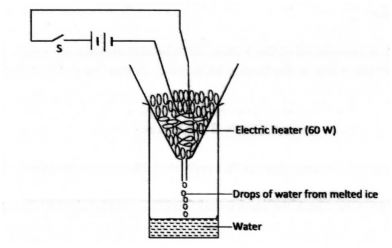
Figure 8
The following readings were noted after the heater was switched on for 5 minutes:
– mass of beaker = 130 g
– mass of beaker + melted ice = 190 g
(i) Determine the:
(I) energy supplied by the 60 W heater in the 5 minutes. (3 marks)
(II) specific latent heat of fusion of ice. (4 marks)
(ii) It was observed that some of the crushed ice melted even before the heater was switched on. State a reason for this observation. (1 mark)
16 (a) A horizontal force of 12 N is applied on a wooden block of mass 2 kg placed on a horizontal surface. It causes the block to accelerate at 5 ms-2. Determine the frictional force between the block and the surface. (3 marks)
(b) Figure 9 shows a graph of velocity against time for a ball bearing released at the surface of viscous liquid.
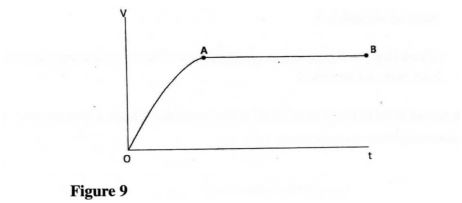
Figure 9
Explain the motion of the ball bearing for parts
(i) OA (2 marks)
(ii) AB (2 marks)
(c) Figure 10 shows a pulley system used to raise a load by applying an effort of 500 N.
Figure 10
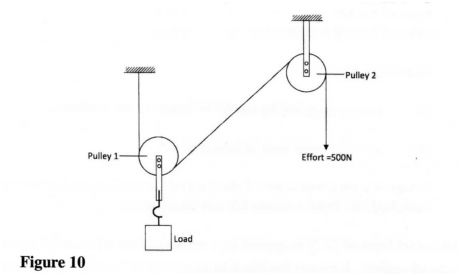
State the:
(i) velocity ratio of the system. (1 mark)
(ii) purpose of pulley 2. (1 mark)
(iii) Given that the machine has an efficiency of 80%, determine the maximum load that can be raised. (3 marks)
17 Figure 11 shows an insulated cylinder fitted with a pressure gauge, a heating coil and a frictionless piston of cross-sectional area 100 cm2.
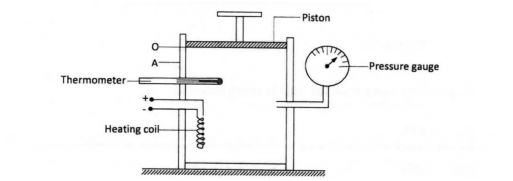
Figure 11
(a) While the piston is at position O, the pressure of the enclosed gas is 10 Ncm-2 at a temperature of 27°C. When a 10 kg mass is placed on the piston, it comes to rest at position A without change in the temperature of the gas.
(i) Determine the new reading on the pressure gauge. (4 marks)
(ii) State with a reason how the value obtained in (i) compares with the initial pressure. (2 marks)
(b) The gas is now heated by the heating coil so that the piston moves back to the original position O.
(i) State the reading on the pressure gauge. (1 mark)
(ii) Determine the temperature of the gas in °C. (4 marks)
(Take g = 10 Nkg-1).
18 (a) Figure 12 shows a weighing balance on which a beaker containing some water is placed. The reading on the balance is 2.80 N. A metal block weighing 2.7 N is suspended from a spring balance.
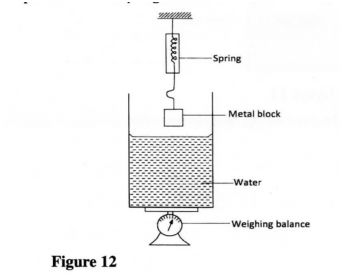
Figure 12
(i) State what is observed on the spring balance and the weighing balance, as the metal block is gradually lowered into the water.
(I) Observation on spring balance. (1 mark)
(II) Observation on weighing balance. (1 mark)
(ii) Explain the observation made on the spring balance in (I). (2 marks)
(iii) When the metal block is fully immersed in the water, the reading on the spring balance is found to be 2.46 N. Determine the:
(I) reading on the weighing balance. (2 marks)
(II) density of the metal. (3 marks)
(c) Figure 13 shows a hydrometer with a thin stem floating in water in a beaker.
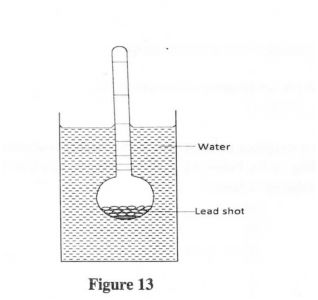
Figure 13
State with a reason what is observed on the hydrometer when the temperature of the water is raised. (2 marks)
3.5.2 Physics Paper 2 (232/2)
SECTION A (25 marks)
Answer all the questions in this section.
1 State the reason why when a ray of light strikes a mirror at 900, the reflected ray travels along the same path as the incident ray. (1 mark)
2 Explain why the image formed in a pin hole camera gets blurred when the hole is enlarged. (2 marks)
3 State the reason why the magnetic field strength of a magnet is greatest at the poles. (1 mark)
4 Figure 1 shows a cell of e.m.f. 2 V connected in series with a resistor R and a switch S.
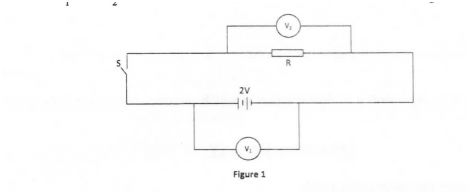
(a) State the reading of V1 with S open. (1 mark)
(b) With S closed, V1 reads 1.6 V. State the reading of V2. (1 mark)
5 centre of curvature of the mirror.
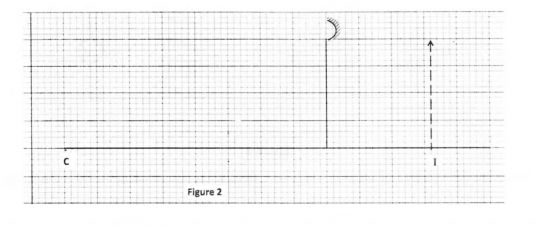
Complete the diagram to show:
(a) how incident rays are reflected to form the image; (2 marks)
(b) the object position. (1 mark)
6 Figure 3 shows a ray of light passing into a glass prism ABC.
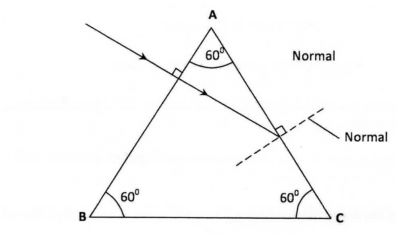
(a) Determine the values of a and b. (1 mark)
(b) Identify X. (1 mark)
8 Figure 4 shows a simple transformer connected to a 12 V a.c. source and an a.c. voltmeter.
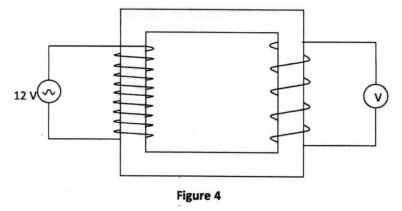
By counting the number of turns in each coil, determine the reading on the voltmeter.
9 In domestic wiring systems lamps in the lighting circuit are required to be in parallel and not in are connected in series with a switch, a cell and a milliameter.
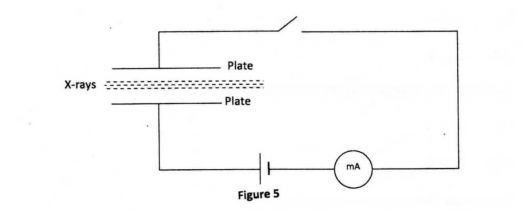
observation. (2 marks)
burning wood is cut off by the glass sheet. (2 marks)
12 A photon of ultraviolet light having energy E falls on a photoemissive surface whose work function is T. Write an expression for the maximum kinetic energy of the resulting photoelectron in terms of E and T. (1 mark).
13 When a germanium crystal is doped with arsenic, it becomes an N-type semiconductor. Explain how this change occurs. (2 marks)
(Number of electrons in the outermost shell for germanium = 4, Arsenic = 5)
SECTION B (55 marks)
Answer all the questions in this section.
14 Figure 6 shows two convex lenses A and B used to produce a magnified virtual image of an object.
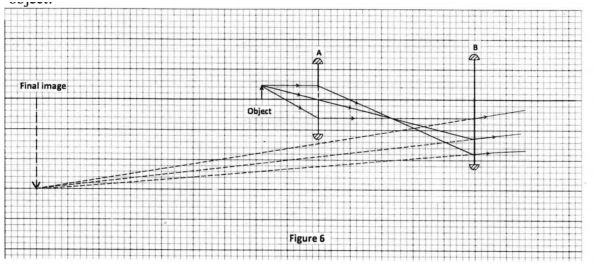
(a) Determine the focal length of lens A. (Take 1unit to represent 10cm).
(b) State the function of:
(i) lens A (1 mark)
(ii) lens B (1 mark)
(c) State how the functions in (b) are achieved by:
(i) lens A (1 mark)
(ii) lens B (1 mark)
(d) Determine the magnification produced by:
(i) lens A; (2 marks)
(ii) the whole system. (2 marks)
15 (a) Explain how a positively charged electroscope gets discharged when the cap is touched with a finger. (2 marks)
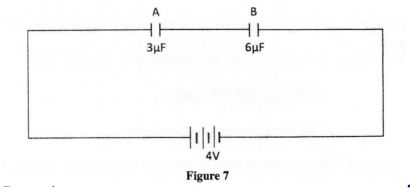
(b) Figure 7 shows capacitors A and B connected in series with a battery of e.m.f 4 V.
Determine:
(i) the effective capacitance of the circuit. (3 marks)
(ii) the quantity of charge in capacitor A. (3 marks)
(iii) the quantity of charge in capacitor B. (1 mark)
(c) Figure 8 shows an isolated negative point charge Q.
On the figure, sketch the electric field pattern around the charge. (2 marks)
16 (a) Two points A and B have a potential difference of V volts. Q coulombs of charge flow
(i) the electrical energy transformed between the two points in terms of Q. (1 mark)
(ii) the power transformed in terms of Q and t. (1 mark)
(iii) show that the power transformed is given by P = IV. (2 marks)
(b) The lighting circuit in a house has 20 lamps each rated 60 W, 240 V. Determine whether a fuse rated 4 A can be used in the circuit when all the lamps are put on. (4 marks)
17 (a) Figure 9 shows a cathode ray tube in which a beam of electrons is cast on the screen.
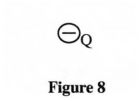
Figure 9
(i) state how the electrons are produced in the tube. (1 mark)
(ii) state how the electron beam is detected. (1 mark)
(iii) State the reason for having a variable potential difference (p.d.) at the:
(I) grid; (1 mark)
(II) anodes. (1 mark)
(b) Figure 10 shows the waveform of a signal applied at the y-plates of an oscilloscope whose time-base is switched to the scale of 2 milliseconds per centimeter.
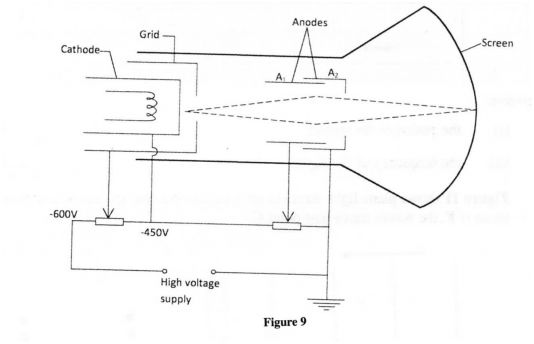
Determine:
(i) the period of the signal; (2 marks)
(ii) the frequency of the signal. (3 marks)
18 (a) Figure 11 shows plane light waves in air incident on a convex lens whose principal focus is F, the waves move past point G.
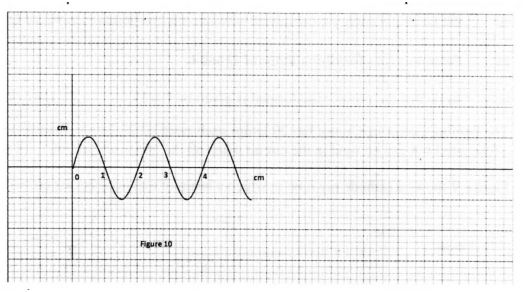
Complete the diagram to show the pattern of the emergent waves between the lens and point G. (2 marks)
(b) Figure 12 shows crests of circular water waves spreading from two points A and B
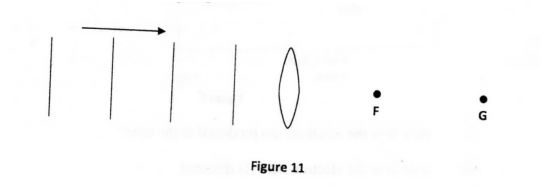
Figure 12
Given that the amplitude of each wave is 5 cm, state with a reason the amplitudes of the
(i) C; (2 marks)
(ii) D. (2 marks)
(c) Figure 13 shows a standing wave formed when a string of length 1.5 m stretched between two supports is plucked in the middle.
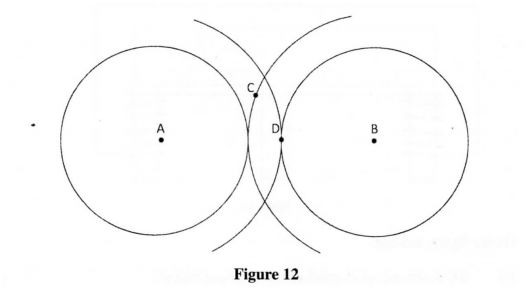
Figure 13
(i) Explain how the standing wave is formed. (3 marks)
(ii) Determine the wavelength of the standing wave. (1 mark)
coils in series.
19 On the figure, indicate
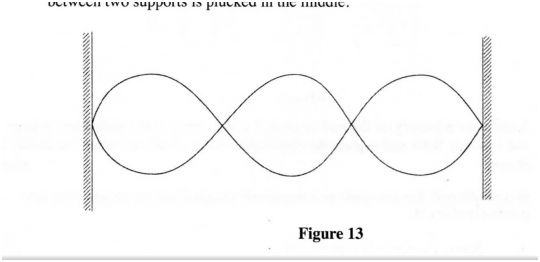
(i) the north and south poles of the resulting magnet (1 mark)
(ii) the complete magnetic field pattern between the poles. (1 mark)
(b) Figure 15 shows the permanent magnet made in part (a) above.
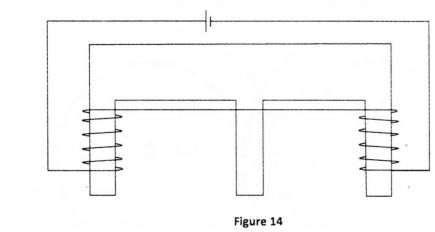
A coil wound loosely on the middle limb is connected in series with a low voltage a.c. and a switch. State and explain the observation made on the coil when the switch is closed. (2 marks)
positively charged.
(i) Name the electrolyte in the cell. (1 mark)
(ii) Explain how:
(I) Zinc gets negatively charged. (1 mark)
(II) Copper gets positively charged (1 mark)
(iii) State what constitutes the current when a wire is used to connect the zinc plate and the copper plate externally. (1 mark)
3.5.3 Physics Paper 3 (232/3)
Question 1 . This question consists of two parts A and B; attempt both parts.
PART A
You are provided with the following:
– a pendulum bob
– a stop-watch
– two metre rules
– two retort stands, two bosses and two clamps.
– some thread.
Proceed as follows:
(a) Clamp one metre rule horizontally on the two stands so that the graduations are in a vertical plane. Suspend the pendulum bob from the metre rule with two pieces of thread so that the length of each thread from the point of support on the metre rule to the pendulum bob is 50 cm. See figure 1. The length of each thread will remain 50 cm throughout the experiment. The height of the metre rule above the bench should be at least 65 cm.
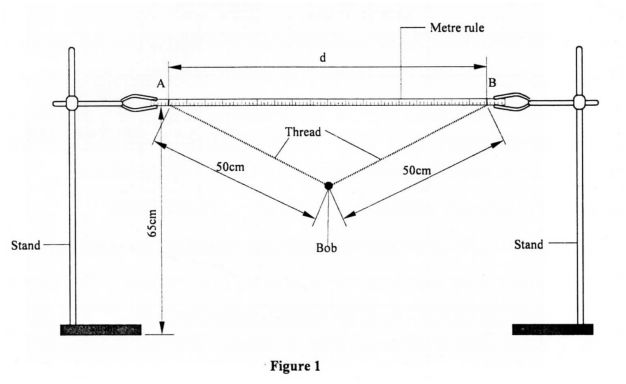
(4 marks)
(d) (i) Plot a graph of T4 (y – axis) against d2. (4 marks)
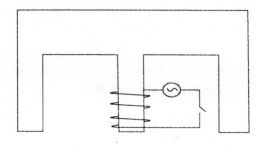
in a plane perpendicular to the length of the metre rule and release it so that it oscillates (c) Repeat the procedure in (b) for other values of d shown in table 1. Complete the table.
Table 1
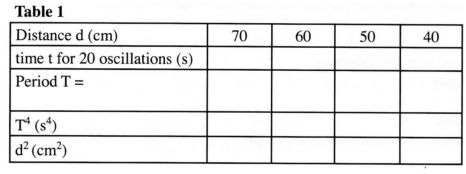
(ii) Determine the slopes S of the graph. (2 marks)
, determine the value of K. (2 marks)
PART B
You are provided with the following:
– one meter rule
– a piece of thread
– stop watch
Proceed as follows.
(e) Using the meter rule measure the length L and breadth b for the magnet.
L = ………………………………
b = ……………………………… (1 mark)
(f) Use the balance to measure the mass M of the magnet.
M = ……………………………. kg. (1 mark)
(h) Clamp the meter rule between the two resort stands. Using a piece of thread suspend in a horizontal plane as shown in figure 2.
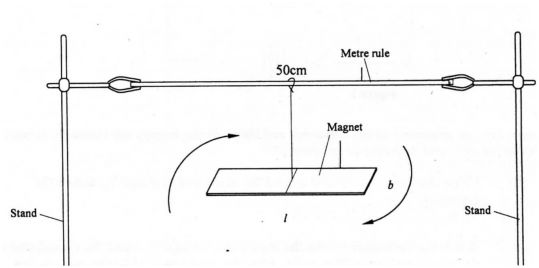
Keep away all unnecessary magnetic materials including voltmeter form this a vertical axis through its centre as shown by the arrows. Measure the time t for
(a) t = …………………………..
(II) Determine the period T of the oscillations. (1 mark)
G
Question 2
This question consists of two parts A and B, attempt both parts.
PART A
You are provided with the following
– a voltmeter
– a capacitor
– a switch
– a stop watch
– five connecting wires
– two cells and a cell holder
Proceed as follows:
(a) Connect the circuit as shown in figure 3.
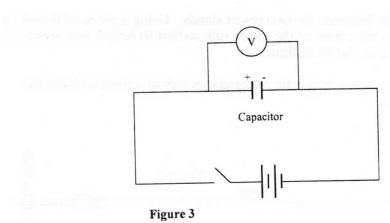
Make sure that the terminals of the capacitor and those of the battery are correctly connected, capacitor.
the stop watch simultaneously. Stop the stopwatch when the voltage has (d) Reset the stopwatch and close the switch. Repeat the procedure in (c) to of the other values shown in table 2.
Table 2
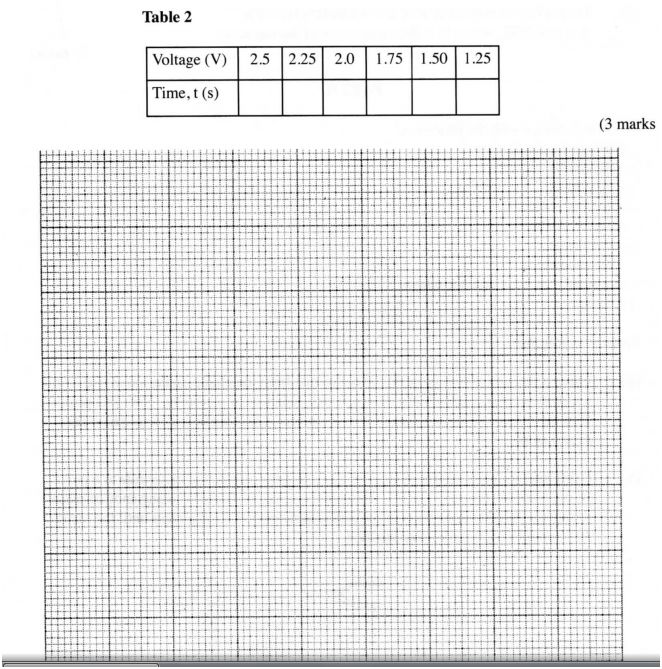
(e) (i) On the grid provided, plot a graph of Voltage V (y-axis) against time t,
(4 marks)
t =…………………. seconds (1 mark) (1 mark)
PART B
You are provided with the following:
– a triangular glass prism
– a metre rule
– a 50 g mass
– some hot water
– some cold water
– some thread
– a thermometer,p> – one stand, one boss and one clamp
– a beaker
Proceed as follows:
(g) Using a piece of thread suspend the metre rule from the clamp on the stand and adjust the position of the thread until the metre rule balances horizontally. Note this position, O of the thread. (This position of the thread must be maintained throughout the experiment).
(h) Using another piece of thread suspend the glass prism from the meter rule at a point 35 cm from O. Suspend the 50 g mass on the opposite side of O using another piece of thread. Adjust the position of the thread attached to the 50 g mass until the metre rule balances once more. See figure 4.
mass. l1 = …………………… cm (1 mark)
(Take g = 10 N kg-1) (1 mark)
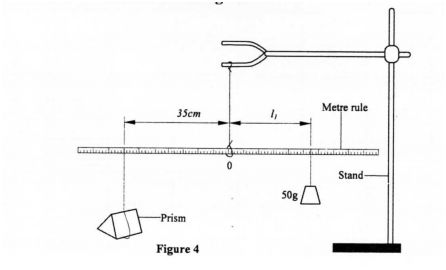
(i) Put cold water into the beaker (approximately three quarter ( 3 4 full). With the glass balances when the prism is fully submerged in the cold water. See figure 5.
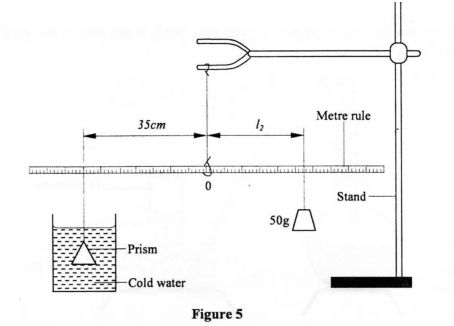
(I) l2 = …………………….. cm (1 mark)
(II) Determine the weight W2 of the prism in the cold water. (1 mark)
(j) Measure and record the temperature T1 of the cold water when the system is balanced. T1 = …………………….. oC (1 mark)
(k) Now pour out the cold water and replace it with hot water. Balance the metre rule at 35 cm from 0. is submerged in hot water.
l3 = …………………. cm. (1 mark)
(ii) Measure and record the temperature T2 of the hot water.
T2 =……………………. oC (1 mark)
(iii) Determine the weight W3 of the prism in hot water. (1 mark)
(l) Determine the constant k for the water given that:
k = (w1 – w2) – (w1 – w3)
(w1 – w3) ( T2 – T1)
(2 marks)
2013 KCSE Physics Past Paper-Marking Scheme/Answers
5.4.1 Physics Paper 1 (232/1)
1. 5.32 cm (1 mark)
2. – magnitude of the force
– The perpendicular distance between the force and the pivot. (1 mark)
3. Patmosphere = Pmercury + pair enclosed;
Pair = 760 – 600:
= 160 mm Hg;
(3 marks)
4. (a) F = Ke;
20 = 0.5 K;
K = 40 Ncm” (2 marks)
(b) F = 40 x 0.86 = = 34.4 N;
(1 mark)
5. – Weight of object in air
– Weight of object when fully immersed in fluids (2 marks)
6. Upthrust = weight in air – weight of object in fluid. (1 mark)
7. Wood is a poor conductor of heat; hence heat is used to bum paper, while most heat is conducted away by copper: hence paper takes long to bum. (2 marks)
8. Clockwise moments = anticlockwise moments;
0.l8x = l(50-x)+0.12(l00-x)
0.l8x = 50-x+l2-l2x
O.l8x = 62- 1.l2x
7.30x = 62
x = 47.69 cm; (3 marks)
9. Air is compressible; so the transmitted pressure is reduced; (2 marks)
10. The high velocity of the gas causes a low pressure region;
Atmospheric pressure is higher;
Pressure difference draws air into the region; (3 marks)
11. Water molecules have a high adhesion forces; With glass molecules and hence rise up the tube while mercury molecules have greater cohesion;
Forces within than adhesion with glass hence do not rise up. (2 marks)
12. Allow for expansion;
Water expands on cooling between 4° C and 0° C;
13 Diffusion of the ink molecules;
SECTION B
14 (a) – increasing the angular velocity;
– Reducing the radius of the path;
(b) (i) Tension in the string;
(ii) Arrow to centre of circle;
(iii) Direction of motion of object changes and causes the velocity to change with time;
(iv) F = mv/r
0.5 * 8*2/2
= l6N;
(c) (i) V2 = uz + 2as;
O€u’—2>< 10>< 100
u= ‘/ 2000
44.72 ms”;
(ii) V = u + at ;
O = 44.72 – 10 X t
t= 4.472
Total time = 2 X 4.472
= 8.94s ;
temperature;
(b) (i) E=Pt;
=6O><5 X60;
= 13000];
(ii) Mass of water = 190 – 130 = 60g;
mlf = Pt.
60 = .
——1OO0l, 60><60><5,
1,= 3 >< 105 J/Kg;
15 (a) Quantity of heat required to convert 1 kg of ice at 0° C to water without change in temperatures
(iii) Heat from the surrounding melts the ice; (1 mark)
16 a) F = Ma;
F = 2 >< 5
= ION;
friction force = 12 – 10
= 2N; (3 marks)
(b) (i) OA – the ball bearing decelerates; as the upthrust increases to a maximum; (2 marks)
AB – ball attains terminal velocity; when upthrust = weight; (2 marks)
(c) (i) VR = 2 (1 mark)
(ii) To change direction of effort; (1 mark)
(iii) Efficiency =—1‘”% >< 100;
so=%><1o0%
MA=l.6;
..1.6_5O0
” L=500X 1.6
=800 N; (3 marks)
17 (a) (i) F = mg
= 10 X 10
= 100 N ;
Additional pressure = = 1 Ncm ’
new reading = 10 + 1 = ll N; (4 marks)
(ii) Pressure has increased; because, when the volume reduces, the collisions between the gas molecules and walls of the container increases; (2 marks)
(b) (i) Pressure = ll Ncm’2 _ (1 mark)
(11) Q = i;
Tr T1
L = L-
300 T1 ‘
T1=i3°‘)l:)‘ 11 = 330k;
T2 = 57° C (4 marks)
18 (a) (i) (I) – Reading decreases on spring balance;
(II) – Reading on weighing balance increases.
(ii) As the block is lowered, upthust increases;
and hence it apparently weighs less;
(b) (i) Upthrust – weight in air – weight in water
= 2.7 – 2.46
= 0.24 N;
Reading in weighing balance = 2.8 + 0.24
= 3.04 N;
(ii) Relative density = weight in air;
upthrust
= 11
0.24
= 11.25 ;
Density = R.d X density of water
= 11.25 >< 1000
= 11250 kgm‘;
c) The hydrometer sinks more;
The density of(t.he water is reduced;
5.4.2 Physics Paper 2 (232/2)
SECTION A
1 angle of incidence = angle of reflection = 0 (1 mark)
2 larger hole acts as many small holes (1 mark)
many overlapping images of same object (1 mark)
3 Within the magnet, N and S poles of the dipoles cancel out but at the end of the poles they don’t. (1 mark)
4 (a) 2V (1 mark)
(b) 1.6V (1 mark)
5. Object at the intersection of incident ray; (1 mark)
Incident rays; (2 marks)
6. Ray totally reflected by face AC (1 mark)
i= 6O’hence r= 60′ (1 mark)
7 .a= 1 ar1db=0 (1 mark)
x = neutron (1 mark)
8 .NS/NP=Np/ VP (1 mark)
9. Each lamp on full voltage (1 mark)
Failure of one lamp does not affect the others (1 mark)
10. X rays ionise air molecules between plates
Ions move to plates of opposite sign
11. Sun being hotter produces short wavelength infrared waves which penetrate glass; buming wood produces long wavelength infrared waves which do not penetrate glass.
12. K=E- T
13 Arsenic shares 4 of its 5 electrons with germanium.
the extra electron is free for conduction.
SECTION B
14 (a) fl= l0cm
b i) to produce a magnified real image
ii) to produce a magnified virtual image of the 1*‘ image.
c) i) move A so that the object is slightly outside fik
ii) fiove B so that the real image is within fa.
d)i) m= A
“‘ 16
= 1
2
ii) m = 27f
= 7
15 Negative charges fiow from earth to cap.
Negative charge neutralizes the positive.
b) i) C = 2,uF (1 mark)
(ii) Q=¢V (1 mark)
=2×4
= spc (lmark)
(m) Q= 8/1C (1 mark) ‘
(C) radical field;
Correct dirrection; (2 marks)
16 a) (i) Energy = QV (1 mark)
(ii) Power = 15. = 2 (1 mark)
(iii) I : Q (rate of flow of charge) (1 mark)
P = %.V
P = I.V (1 mark)
(b) Power = VI = 20 x 60 (1 mark)
240 x I = 12O0W (1 mark)
I : 1200
240
= SA (l mark)
4A < 5A hence fuse will blow. (1 mark)
17 (a) (i) Thermionically by cathode (1 mark)
(ii) causing fluorescence on screen (1 mark)
(iii) (i) control brightness of fluorescence (1 mark)
(ii) to focus the electron beam (1 mark)
(b) 1 wavelength = 2 cm (1 mark) = 4 X10_3S (1 mark)
f = % (1 mark)
= 1 (1 mark)
4><10″
= 250HZ (1 mark)
18 a) – curved waves – converging before focus (1 mark)
– diverging after focus. (1 mark)
(b) (i) O cm – trough and crest interference (2 marks)
(ii) +10 – crest and crest interference (2 marks)
(c) (i) Waves produced are reflected at the fixed ends. (1 mark)
Incident and reflected waves interfer constructively at antinodes. (1 mark)
and destructively at nodes. (1 mark)
(ii) A = %>< 1.5
= 1m (1 mark)
19 b) coil moves to and fro (1 mark)
force on coil varies direction as current varies in direction. (l mark)
(i) dilute sulphuric acid (1 mark)
(ii) (I) Zinc ions go into acid leaving electrons on the plate (1 mark)
(II) Give up electrons to discharge hydrogen Ions. (l mark)
(m) Electrons flow from zinc plate to the copper plate. (I mark)
5.4.3 Physics Paper 3 (23213)
PART A
(d) (i) See graph (5 marks) Scale and axis
Plotting
Line
250—350
(ii) Slope = 2 ;
\d (42 18) X 10
(iii) K
d (1) = -4.2 >< 10* S‘cm’2; (3 marks)
= / 41:<10
= 963 S“cm’2;
1. PART B
(c) 1=0.1m
b=0.0l m
m=0.06 kg
0/W
(g) p = Lg“ (0.11 + 0.011)
= 2.02 >< 10*‘
(i) (I) (II) t=75s
T=7.5s 2 c
2. PART A
G = 1.42 >< 10
unit not required.
(b) V0 = 3.0V
PART B
(h) (i)
(ii) W
k
Vo1tage(V)
2.5 2.25 2.0 1.75 1.5 1.25
Time(s)
1.7 2.6 3.9 4.8 6.5 7.9
(i) see graph
(ii) t% =6.4 S
R I 6.4 X10“
0.693 >< 2200
= 4200 Q
LI = 47.4 cm
= 0.68 N
_ 0.474 >< 0.05 >< 10
I ‘ 0.35
(I) L2=28 cm
_ 0.28 X 0.05 ><10
1- 0 35
(11) w
= 0.4 N
T1 = 26°C
Accept (18 – 32°C)
(i) L3 = 28.5 cm
(ii) T2 = 83°C
Accept (60 – 95°C)
(iii) W3 = 0.285 X 10
= 0.41
K = (0.68 — 0.4)— (0.68— 0.41)
(0.68 — 0.41) (83— 26)
= Milli
0.27 >< 57
= 6.5 >< l0“‘K”

